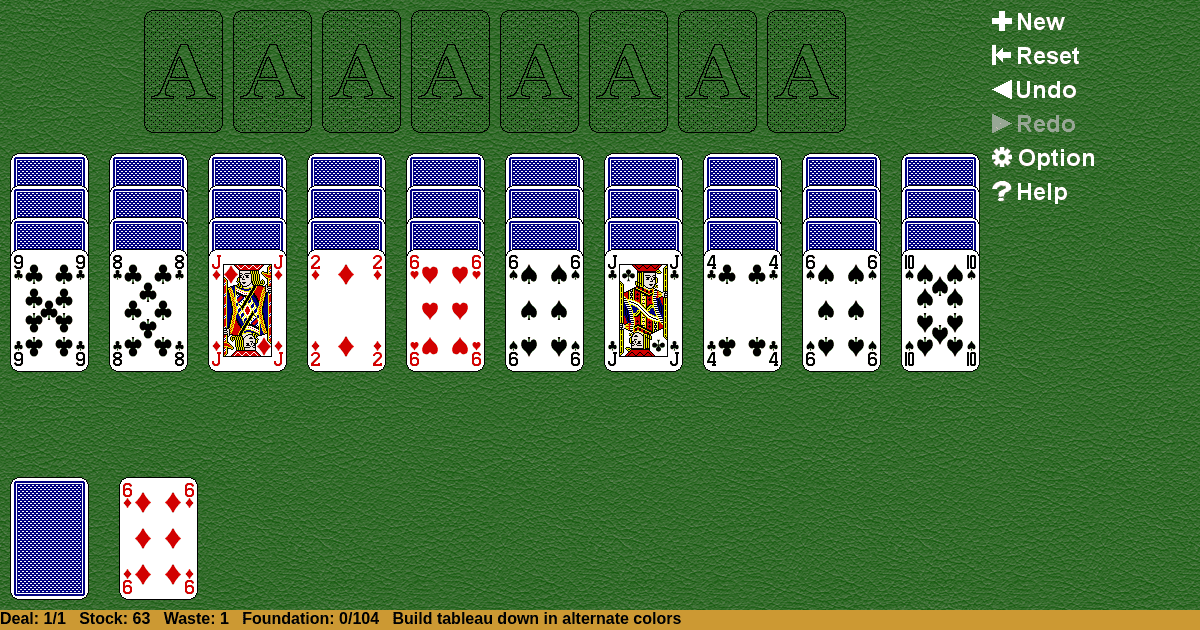Emperor
Home |
How to play |
FAQ |
About
How to play Emperor?
Game Objective:
The primary goal in Emperor Solitaire is to move all cards from the tableau and stock to the eight foundation piles, building each foundation up by suit from Ace through King.
Setup & Layout:
- Deck: Use two standard 52-card decks (104 cards total), with Jokers removed.
- Tableau: Deal ten tableau piles, each with four cards:
- In each pile, the bottom three cards are dealt face-down.
- The top card of each pile is dealt face-up.
- Foundations: Reserve space above the tableau for eight foundation piles (one for each suit from each deck).
- Stock: Place the remaining cards face-down in a single pile (the stock).
- Waste: As play progresses, a waste pile will form next to the stock, where unplayable cards from the stock are placed face-up; only the top card of the waste is accessible.
Key Play Areas Defined:
- Tableau: The main area with ten piles where most card movement occurs.
- Foundations: Where cards are built up by suit from Ace to King.
- Stock: The draw pile for new cards.
- Waste: Discards from the stock, with only the top card available for play.
Emperor Solitaire Rules:
- Foundations:
- Foundations are built up by suit, starting with Ace and ending with King.
- Only Aces may start a foundation pile.
- Cards must be added in ascending order (Ace, 2, 3, …, King) and must match the suit of the foundation.
- Tableau:
- Cards are built down by alternating color (red on black or black on red) and in descending rank (e.g., 9♣ on 10♦).
- Only the top face-up card of each tableau pile is available for play.
- When a face-up card is moved, immediately flip the next face-down card in that pile face-up.
- Any single card may be moved to an empty tableau pile.
- In modern variants, sequences of cards in correct order and alternating colors may be moved as a unit; in classical rules, only single cards may be moved.
- Stock and Waste:
- Cards are drawn one at a time from the stock to the waste pile.
- The top card of the waste pile is always available for play to either the tableau or the foundations.
- If a card from the stock cannot be played, it remains on the waste pile.
- Card Movement:
- Only the top card of each tableau pile or the waste pile may be moved.
- Cards may move from tableau to tableau, tableau to foundation, or waste to tableau/foundation, following the above rules.
Gameplay:
- Turn Sequence:
- Move any available face-up cards from the tableau or waste pile to either another tableau pile (following descending, alternating color rules) or to the foundations (in ascending suit order).
- Whenever a face-down card in the tableau is uncovered, immediately flip it face-up.
- When no more moves are possible or desired, draw the top card from the stock and place it face-up on the waste pile.
- Continue moving cards and drawing from the stock until all cards are placed in the foundations or no more legal moves are possible.
- Introducing New Cards:
- Cards are introduced into play either by flipping face-down cards in the tableau or by drawing from the stock to the waste.
- If No Moves Are Available:
- If no moves are possible in the tableau or from the waste, draw from the stock.
- The game ends when the stock is exhausted and no further moves can be made.
Winning & Losing Conditions:
- Winning:
- The game is won when all 104 cards are successfully moved to the eight foundation piles, each built up from Ace to King in suit.
- Losing/Unwinnable State:
- The game is lost or unwinnable if the stock is exhausted and no further legal moves are possible in the tableau or with the waste pile.
Special Rules & Edge Cases:
- Empty Tableau Piles:
- Any single card may be moved to an empty tableau pile.
- In some variants, packed sequences (correctly ordered, alternating colors) may also be moved to empty spaces, but the classical rule restricts this to single cards only.
- Aces to Foundations:
- Aces must be moved to the foundations as soon as they become available, either from the tableau or the waste.
- Sequence Movement:
- Only the top card of each tableau pile is movable in classical rules; some modern versions allow moving entire sequences that are in correct descending, alternating color order.
- No Redeal:
- There is no redeal; once the stock is exhausted, you cannot reshuffle or reuse the waste pile.
- Waste Pile Visibility:
- The top card of the waste pile is always available for play; players may overlap cards in the waste pile to keep all visible, but only the top card is playable.
- Multiple Foundations:
- There are eight foundations, one for each suit from both decks. Each must be built up independently.
Note: The above rules are based on official and widely accepted sources for Emperor Solitaire. Minor variations may exist, but these represent the standard gameplay mechanics.

Solitaire Collection
About Emperor
Rate (Emperor)
4.7 / 5
1,916 votes



























































